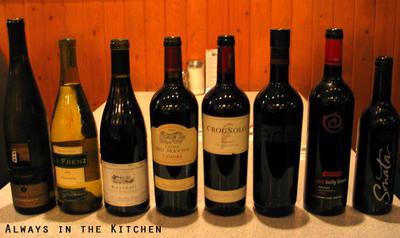 This week's tasting was going to be New Zealand wines but misfortune occured, in the guise of a truck being towed, which prevented our buyer from making it out to collect the wines. As in the past, we relied instead on our director's stash of goodies to produce an eclectic variety of wines.
This week's tasting was going to be New Zealand wines but misfortune occured, in the guise of a truck being towed, which prevented our buyer from making it out to collect the wines. As in the past, we relied instead on our director's stash of goodies to produce an eclectic variety of wines.We tasted eight wines - somehow managing one more than our usual seven, despite the logistical challenges. As is our custom when tasting both white and red wines, we started with the white and moved on to the red, positioning the bigger, more assertive wines toward the end. It's hard to go back to a frisky yet delicate little chablis (for example) after you've been conked over the head with a shiraz.
In that spirit, we started with two BC wines - the 2002 Hillside Kerner ($14.95) and the 2003 LaFrenz Chardonnay ($17.90). The Kerner was quite popular, although with very low acids and mild flavours, it was suggested that it would be a good patio wine - easy drinking, undemanding, and easy to pair with snack-foods or a selection of cheeses. The LaFrenz, however, failed to garner much appreciation. I should be clear in attributing that to the fact that our tiny wine club harbours few Chardonnay-lovers, as the wine itself was quite typical of the grape, with a buttery nose and a vaguely tropical backnote against a palate of mineral oil and straw. Still, at the end of the night, it got a few votes from people who liked it.
The first red was a 2001 Domaine Des Coteaux Des Travers, Rasteau (Cotes du Rhone) from France ($27.95). The pricing is what I like to refer to as "the danger zone" of French wines, where it's really a crapshoot whether you get something tasty or disappointing. This one had a vanilla-bean sweetness on the nose, and a dried-fruit flavour of figs and prunes and a little flintiness, but ultimately was judged not very complex or interesting - although it didn't offend. Overpriced, clearly. Still in France, still in the danger zone, we moved on to the 2001 Francois Pelissie Croix Du Mayne ($22.95). Surprisingly for France, this wine is 85% Malbec and 15% Merlot. It had a great colour - opaque garnet red, and good legs, but the nose was thin and, despite an appealing smokiness on the palate, had a very thin body. Wine Spectator gave it 92 points, but I yet again must disagree with WS's assessment. Only one of the tasters like it.
With some anticipation, we hit Italy with the 1998 Tenuta Sette Ponti Crognolo (IGT) ($53.59)from Tuscany. The nose was very nice - leather and chocolate and allspice (all good things!) and the flavours were simple and bright with strong notes of blackberry. It was a nice wine, but at $53.59 I expect better from Italy. The blend was 90% Sangiovese and 10% Merlot - for body, I presume - and while I'd happily drink a glass handed to me at a party, I won't be buying this one myself. This was the first release of this wine for Sette Ponti, so maybe subsequent wines were worth the cost.
The next wine was the ridiculously named Edge 2002 Cabernet Sauvignon ($36.50) a Napa Valley Cabernet with a big attitude. It is made to compete with the "big boys" - Caymus et. al., but at a lower cost. This was a decidedly enjoyable wine, with a dark, rich body, and a black, dark sweetness that is not at all sugary. There were echoes of dust, leather, blackberries and pepper on both the nose and the palate. It was still a little pricey for what it was, but it was generally well received.
The seventh wine, and the clearest winner of the night, was the 2002 Angoves Red Belly Black Shiraz ($23.95) from South Australia. Once again, Australia provides shockingly decent wines at equally shockingly decent prices. The wine was a dark red with two tiers of legs forming, one low and fat and one high, thinner, and slower. The nose was big and musty, and the palate had an odd-sounding but delicious combination of flinty blackberry leaves, balsamic vinegar, and even the faint sting one associates with battery acid. It was universally liked around the table.
Our final wine was a little more problematic, prompting a decided divide down the table. BC's Calona Vineyards 1999 Sonata Red Dessert Wine (~$20) was clearly designed along the lines of a tawny port. The nose was somewhat flinch-inducing, and the word "armpit" was muttered two or three times. The palate fared somewhat better than the nose, although there was a sort of rotten plum flavour that wouldn't go away for me. There were also notes of caramelized brown sugar, honey, and a somewhat vegetal aftertaste, but still - there were a couple of tasters who liked it enough not only to finish theirs, but to eagerly accept unwanted glasses from the rest of us who would rather have a quick bite of bread and sink back into the arms of Edge or Red Belly Black.
For an impromptu selection, it was a successful tasting, with four of the eight wines getting check marks in the "Tasty!" column.
Next month, New Zealand.
Previous Tastings:
BC Small Lots
Portugese Table Wines
Pinot Noir
South African Red Wines
Spanish Wines
Summer Patio Wines





No comments:
Post a Comment